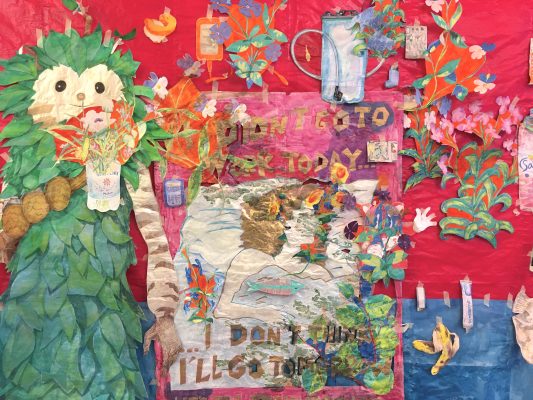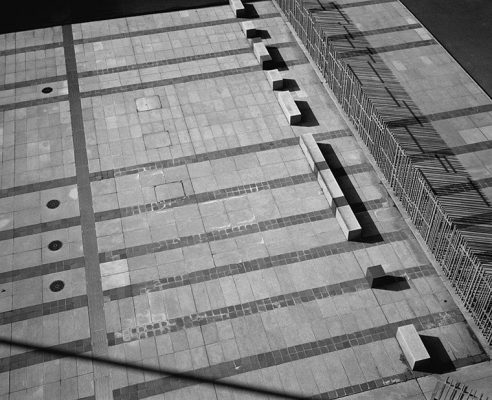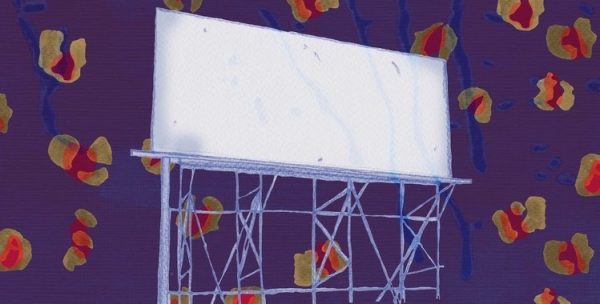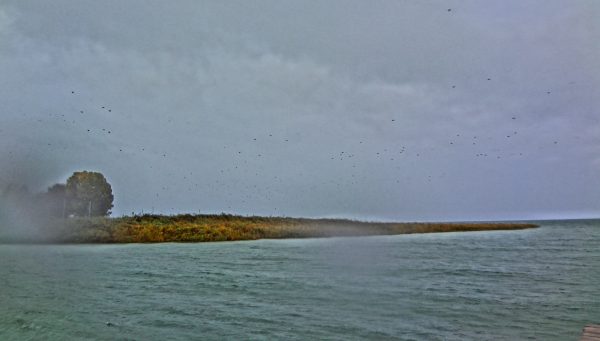The body of a peasant, modelled from ceramic, is strewn on the ground, its muted tones blending in with the cement flooring. Set in a basement room of Goldsmiths CCA, a labyrinthine former bathhouse, this ominous scene could be the site of a murder. The figure is a reference to The Land of Cockaigne (1567), a painting by the Flemish artist Pieter Bruegel the Elder, from which it has been transposed. In Bruegel’s original, three peasants – one in the same pose as the floor sculpture – have collapsed beneath a table laden with food and wine, suggesting a period of indulgence. Both in Bruegel’s exaggerated feast and the ceramic departure, the overstuffed, unconscious body is as much a warning as a promise.
The sculpture appears in Sated Soldier, Sated Peasant, Sated Scribe (2021), an exhibition by the Irish artist Sam Keogh, which includes an installation of collaged drawings and performances exploring radical readings of medieval myths. Cockaigne, the medieval-era dreamland depicted by Bruegel, is a strange purgatorial place between heaven and hell; the only way you can get there is by being a glutton. One of its earliest recorded examples comes from the Kildare Poems, a series of manuscripts from around 1330, which document early Anglo-Irish linguistic developments in the centuries after the Anglo-Norman invasion of Ireland. Likely written by a Franciscan order, the bounties of Cockaigne are weaponised as a satire against a rival order of Cistercian monks. The descriptions of a decadent abbey – there are wells full of treacle and affairs with nuns nearby – suggest an idle lifestyle that deviates from the proper duties of prayer and charity. Elsewhere, its etymology can be traced to Middle French for ‘land of plenty’, deriving from a word for a small sweet cake. A Spanish equivalent suggests ‘fools’ paradise’, and a related Dutch term means ‘lazy luscious-land’.
The myth of Cockaigne largely passed through an oral tradition, with various written or pictorial accounts freezing it in time. Interpretations vary. Some historians have noted that the tale follows an Old Testament structure, comparable to the Garden of Eden story and its moral that getting what you want – knowledge, plenty – can be the worst thing of all. Others have interpreted the myth as a moralising Christian warning against the ‘work shy’. Bruegel’s rendition appears to peddle a moral: three men lie bloated and aimless – greedy, idle and punished – in a picture of spiritual emptiness. In a recent book, Heaven on Earth (2018), the historian T. J. Clark argues that the meaning of Cockaigne, particularly as depicted by Bruegel and those he influenced, is more open-ended, at once a moral about greed and indulgence, as well something more rebellious: a medieval-era class critique. Indeed, from the 1450s onward, many portrayals of Cockaigne took on a distinctly ‘popular’ message – a vision of abundance for all, rather than a cautionary tale – especially as woodblock engravings, a cheaper form of reproduction, became more widespread.
Behind the ceramic peasant on the floor at Goldsmiths CCA, Keogh has installed a series of larger-than-life paper collages, which hang from ceiling to floor, and create a pathway through the gallery basement. The collages abound with imagery, drawn onto thin, durable paper, which Keogh has cut up and glued back together into giant tapestry-like panels, made all the more curious by Keogh’s mixture of medieval and modern minutiae. The collage is structured by a Microsoft Teams calendar grid, half evoking a weaving pattern. Small ceramic objects act as paperweights, huddling in shadowy corners: a toy soldier, a mini roast chicken, a pint-sized decapitated corpse. Within the grid, Keogh draws another medieval source: a set of six Flemish tapestries known as The Lady and the Unicorn (c. 1500). Woven from silk and wool, and kept at the Musée de Cluny in Paris, each tapestry includes a woman in a blooming garden with a unicorn prancing at her side, and illustrate the five senses (sight, taste, hearing, smell, touch) along with a mysterious sixth sense. An inscription at the centre of the sixth tapestry – ‘À mon seul désir’ [To my only desire] – has inspired countless theories as to the nature of this last sense: from free will (in this tapestry, the lady is seen putting a necklace into a box, perhaps deciding for herself who to love and who to renounce) to abstinence (the lady, putting away the necklace, as the internal virgin, choosing chastity over other impulses). Both the lady and her accompanying unicorn are symbols of aristocratic power, the latter often featured on courtly flags and shields, coming to represent Scotland on the Royal coat of arms, beside England’s lion, during unification in 1603. Transposing and reimagining elements from the tapestries, Keogh seems to punk the myths of old. Converting his source material back into ‘cartoons’ – the preparatory drawings for a tapestry or painting – Keogh presents a kind of pound-shop satire, warping the heraldic icons at the heart of this collage. The lady and the unicorn are rearticulated in a contemporary vernacular of comedy and trash. In the collages, beheaded unicorns and blooming flowers blend with Fortnite avatars and a strange assortment of everyday detritus – plastic bottles, keys, a lighter. Contrasting with the original silk, the collages are made with 75 GSM marker paper, a cheap, standard illustrator paper. Keogh’s anti-luxury goes further: Keogh’s intervention seems to interpret the sense of the sixth tapestry, ‘À mon seul désir’, as a defiant kind of pleasure, suggesting joy and satiation can be attained through ‘poor’ materials and perhaps even a little idleness – where an imagery of abundance offers a joyful counter to the drudgery of work.
The exhibition coincides with a spate of books offering critical perspectives on the politics of labour. Whether it’s Lost in Work (2021) by Amelia Horgan, which wrangles with the increasing gap between work and satisfaction, or Gavin Mueller’s defence of nineteenth-century Luddites in Breaking Things at Work (2021), concerns about ‘essential’, low-paid and precarious work have gained a heightened relevance during the pandemic. These books build on David Graeber’s seminal Bullshit Jobs (2018), which set out the realisation that technological advancement and greater productivity had not resulted in a reduction of the working week, a promise vaunted throughout the twentieth century. In turning to medieval Europe, Keogh draws a parallel between feudalism and capitalism: two systems of oppression, which invite anti-work fantasies. Perhaps, as Mark Fisher argued in Capitalist Realism: Is There No Alternative? (2009), capitalism itself is a myth of abundance: an economic failure that will suck planet earth dry, but an imaginative triumph that extinguishes any sense of an alternative. Sated Soldier, Sated Peasant, Sated Scribe (2021) looks back to an earlier time, asking whether myths and icons of aristocratic origin can be repurposed for emancipatory ends – whether we can establish a new relationship with work, desire and abundance to create a culture of joy and sabotage.




